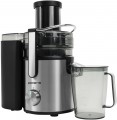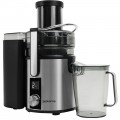Control
Juicer control panel design.
— Control knob.
Mechanical control is carried out using rotary knobs and switches. Most parameters in such devices are set and controlled manually. In this case, the control elements are connected to the working parts of the juicer directly, without additional electronic circuits. This option is simple, reliable and low cost; True, it is only suitable for the most basic functions, but juicers usually do not require more than that.
–
Push-button. Push-button control is based on electronic circuits. Such systems are more accurate than mechanical ones; more capabilities and modes are provided. On the other hand, such control is more complex and more expensive than mechanical control.
–
Touch. A type of
electronic control with touch switches. Compared to push-button models, it provides a high level of comfort in operation, and looks more modern and aesthetically pleasing. Touch control is found mainly in top models of juicers.
Number of speeds
The number of speeds of the juicer. The optimal working speeds for different fruits are different: for example, soft fruits and vegetables need to be pressed at low speeds, solid ones (for example, carrots) — at maximum. In addition, the amount of pulp in the juice depends on the extraction speed: at high speeds it is more, at low speeds the juice is light.
The number of speeds provided by the design of the juicer can vary from 1 to 9. The more speeds, the easier it is to choose the optimal mode for each specific case.
Display
The presence of the display increases the information content of the juicer control. The display can show data on the selected operating mode, centrifuge rotation speed, container fullness (for juice, oilcake), critical situations (engine overload, open lid), etc.

